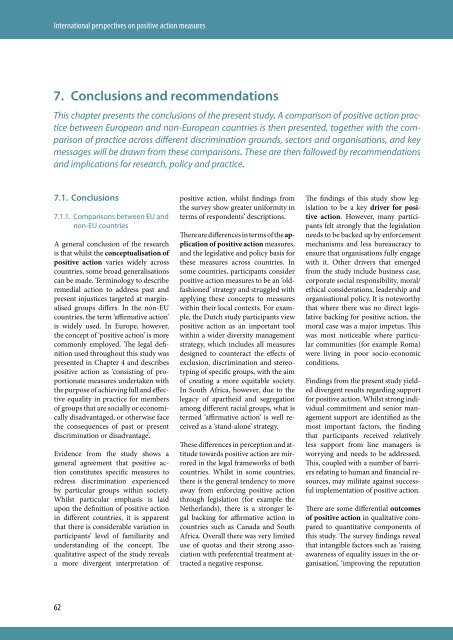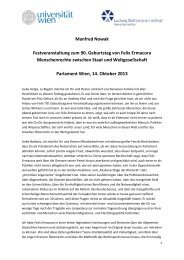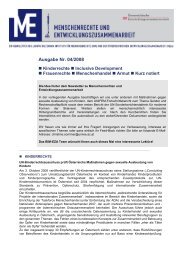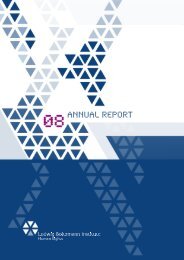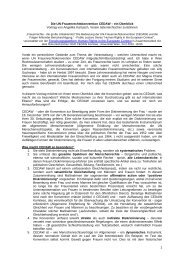International perspectives on positive action measures - European ...
International perspectives on positive action measures - European ...
International perspectives on positive action measures - European ...
Create successful ePaper yourself
Turn your PDF publications into a flip-book with our unique Google optimized e-Paper software.
<str<strong>on</strong>g>Internati<strong>on</strong>al</str<strong>on</strong>g> <str<strong>on</strong>g>perspectives</str<strong>on</strong>g> <strong>on</strong> <strong>positive</strong> acti<strong>on</strong> <strong>measures</strong><br />
7.<br />
7.1. C<strong>on</strong>clusi<strong>on</strong>s<br />
7.1.1. Comparis<strong>on</strong>s between EU and<br />
n<strong>on</strong>-EU countries<br />
A general c<strong>on</strong>clusi<strong>on</strong> of the research<br />
is that whilst the c<strong>on</strong>ceptualisati<strong>on</strong> of<br />
<strong>positive</strong> acti<strong>on</strong> varies widely across<br />
countries, some broad generalisati<strong>on</strong>s<br />
can be made. Terminology to describe<br />
remedial acti<strong>on</strong> to address past and<br />
present injustices targeted at marginalised<br />
groups differs. In the n<strong>on</strong>-EU<br />
countries, the term ‘affirmative acti<strong>on</strong>’<br />
is widely used. In Europe, however,<br />
the c<strong>on</strong>cept of ‘<strong>positive</strong> acti<strong>on</strong>’ is more<br />
comm<strong>on</strong>ly employed. The legal definiti<strong>on</strong><br />
used throughout this study was<br />
presented in Chapter 4 and describes<br />
<strong>positive</strong> acti<strong>on</strong> as ‘c<strong>on</strong>sisting of proporti<strong>on</strong>ate<br />
<strong>measures</strong> undertaken with<br />
the purpose of achieving full and effective<br />
equality in practice for members<br />
of groups that are socially or ec<strong>on</strong>omically<br />
disadvantaged, or otherwise face<br />
the c<strong>on</strong>sequences of past or present<br />
discriminati<strong>on</strong> or disadvantage’.<br />
Evidence from the study shows a<br />
general agreement that <strong>positive</strong> acti<strong>on</strong><br />
c<strong>on</strong>stitutes specific <strong>measures</strong> to<br />
redress discriminati<strong>on</strong> experienced<br />
by particular groups within society.<br />
Whilst particular emphasis is laid<br />
up<strong>on</strong> the definiti<strong>on</strong> of <strong>positive</strong> acti<strong>on</strong><br />
in different countries, it is apparent<br />
that there is c<strong>on</strong>siderable variati<strong>on</strong> in<br />
participants’ level of familiarity and<br />
understanding of the c<strong>on</strong>cept. The<br />
qualitative aspect of the study reveals<br />
a more divergent interpretati<strong>on</strong> of<br />
62<br />
C<strong>on</strong>clusi<strong>on</strong>s and recommendati<strong>on</strong>s<br />
This chapter presents the c<strong>on</strong>clusi<strong>on</strong>s of the present study. A comparis<strong>on</strong> of <strong>positive</strong> acti<strong>on</strong> practice<br />
between <strong>European</strong> and n<strong>on</strong>-<strong>European</strong> countries is then presented, together with the comparis<strong>on</strong><br />
of practice across different discriminati<strong>on</strong> grounds, sectors and organisati<strong>on</strong>s, and key<br />
messages will be drawn from these comparis<strong>on</strong>s. These are then followed by recommendati<strong>on</strong>s<br />
and implicati<strong>on</strong>s for research, policy and practice.<br />
<strong>positive</strong> acti<strong>on</strong>, whilst findings from<br />
the survey show greater uniformity in<br />
terms of resp<strong>on</strong>dents’ descripti<strong>on</strong>s.<br />
There are differences in terms of the applicati<strong>on</strong><br />
of <strong>positive</strong> acti<strong>on</strong> <strong>measures</strong>,<br />
and the legislative and policy basis for<br />
these <strong>measures</strong> across countries. In<br />
some countries, participants c<strong>on</strong>sider<br />
<strong>positive</strong> acti<strong>on</strong> <strong>measures</strong> to be an ‘oldfashi<strong>on</strong>ed’<br />
strategy and struggled with<br />
applying these c<strong>on</strong>cepts to <strong>measures</strong><br />
within their local c<strong>on</strong>texts. For example,<br />
the Dutch study participants view<br />
<strong>positive</strong> acti<strong>on</strong> as an important tool<br />
within a wider diversity management<br />
strategy, which includes all <strong>measures</strong><br />
designed to counteract the effects of<br />
exclusi<strong>on</strong>, discriminati<strong>on</strong> and stereotyping<br />
of specific groups, with the aim<br />
of creating a more equitable society.<br />
In South Africa, however, due to the<br />
legacy of apartheid and segregati<strong>on</strong><br />
am<strong>on</strong>g different racial groups, what is<br />
termed ‘affirmative acti<strong>on</strong>’ is well received<br />
as a ‘stand-al<strong>on</strong>e’ strategy.<br />
These differences in percepti<strong>on</strong> and attitude<br />
towards <strong>positive</strong> acti<strong>on</strong> are mirrored<br />
in the legal frameworks of both<br />
countries. Whilst in some countries,<br />
there is the general tendency to move<br />
away from enforcing <strong>positive</strong> acti<strong>on</strong><br />
through legislati<strong>on</strong> (for example the<br />
Netherlands), there is a str<strong>on</strong>ger legal<br />
backing for affirmative acti<strong>on</strong> in<br />
countries such as Canada and South<br />
Africa. Overall there was very limited<br />
use of quotas and their str<strong>on</strong>g associati<strong>on</strong><br />
with preferential treatment attracted<br />
a negative resp<strong>on</strong>se.<br />
The findings of this study show legislati<strong>on</strong><br />
to be a key driver for <strong>positive</strong><br />
acti<strong>on</strong>. However, many participants<br />
felt str<strong>on</strong>gly that the legislati<strong>on</strong><br />
needs to be backed up by enforcement<br />
mechanisms and less bureaucracy to<br />
ensure that organisati<strong>on</strong>s fully engage<br />
with it. Other drivers that emerged<br />
from the study include business case,<br />
corporate social resp<strong>on</strong>sibility, moral/<br />
ethical c<strong>on</strong>siderati<strong>on</strong>s, leadership and<br />
organisati<strong>on</strong>al policy. It is noteworthy<br />
that where there was no direct legislative<br />
backing for <strong>positive</strong> acti<strong>on</strong>, the<br />
moral case was a major impetus. This<br />
was most noticeable where particular<br />
communities (for example Roma)<br />
were living in poor socio-ec<strong>on</strong>omic<br />
c<strong>on</strong>diti<strong>on</strong>s.<br />
Findings from the present study yielded<br />
divergent results regarding support<br />
for <strong>positive</strong> acti<strong>on</strong>. Whilst str<strong>on</strong>g individual<br />
commitment and senior management<br />
support are identified as the<br />
most important factors, the finding<br />
that participants received relatively<br />
less support from line managers is<br />
worrying and needs to be addressed.<br />
This, coupled with a number of barriers<br />
relating to human and financial resources,<br />
may militate against successful<br />
implementati<strong>on</strong> of <strong>positive</strong> acti<strong>on</strong>.<br />
There are some differential outcomes<br />
of <strong>positive</strong> acti<strong>on</strong> in qualitative compared<br />
to quantitative comp<strong>on</strong>ents of<br />
this study. The survey findings reveal<br />
that intangible factors such as ‘raising<br />
awareness of equality issues in the organisati<strong>on</strong>’,<br />
‘improving the reputati<strong>on</strong>


